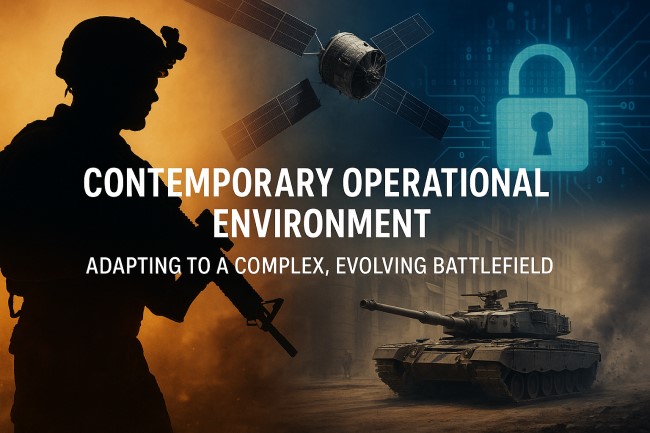Contemporary Operational Environment: Adapting to a Complex, Evolving Battlefield

The contemporary operational environment (COE) is an ever-changing, multifaceted space where modern conflicts unfold. It blends traditional warfare with non-traditional threats such as cyber attacks, information warfare, irregular forces, and rapidly advancing technologies. Understanding and adapting to this environment is essential for military, security, and strategic operations worldwide.
In this article, we explore the key elements of the contemporary operational environment, discuss how it differs from past battlefields, and examine the tools, technologies, and strategies required to succeed in this complex setting. We’ll also explore the closely related term, the contemporary operating environment, which often overlaps with COE in discussions about modern warfare and national defense.
Understanding the Contemporary Operational Environment
The contemporary operational environment refers to the current global landscape in which military and security operations take place. It includes a combination of physical, informational, cultural, political, and technological elements that shape operational strategies and influence outcomes.
Characteristics of the COE
Modern operational environments are characterized by several defining features:
Multi-Domain Complexity
Military operations today extend beyond land, sea, and air to include cyber, space, and the information domain. This complexity demands that military forces adapt rapidly and coordinate seamlessly across all domains.
Irregular and Hybrid Threats
Adversaries in the contemporary environment often use non-traditional tactics, including insurgency, terrorism, cyber attacks, and influence operations. These hybrid threats blur the lines between war and peace, combatant and civilian.
Urban and Asymmetric Warfare
Conflicts increasingly occur in densely populated urban settings, where identifying targets and minimizing civilian casualties is a constant challenge. Asymmetric tactics—such as ambushes, improvised explosive devices (IEDs), and guerrilla warfare—further complicate operations.
Key Elements Shaping the COE
Political and Social Instability
Fragile governments, internal divisions, and social unrest contribute to instability in many regions. This creates power vacuums that can be exploited by extremist groups and criminal organizations, making stabilization and peacekeeping operations even more complex.
Technological Advancements
Emerging technologies such as artificial intelligence, autonomous systems, satellites, cyber tools, and drones have transformed the way militaries operate. These tools enhance surveillance, decision-making, and lethality, but also increase vulnerability to digital threats.
Information Warfare
In the contemporary operating environment, the battle for information is just as critical as the battle for territory. Disinformation campaigns, propaganda, and psychological operations aim to influence public opinion, degrade morale, and confuse decision-makers.
Environmental and Resource Challenges
Climate change, resource scarcity, and natural disasters are increasingly influencing operational planning. These environmental factors can exacerbate conflicts and require military support for humanitarian and disaster response missions.
Contemporary Operating Environment vs Contemporary Operational Environment
Though used interchangeably, there’s a subtle difference between the two terms:
Contemporary Operating Environment
This term often refers to the local or regional conditions where a particular mission or deployment occurs. It includes physical terrain, weather, enemy forces, local populations, and infrastructure.
Contemporary Operational Environment
This is a broader, strategic-level view that includes global trends, technological advancements, geopolitical dynamics, and the evolving nature of warfare. It’s the overarching context in which all military operations are planned and executed.
Adapting to the COE: Strategic Approaches
Modern militaries and security agencies are restructuring their doctrines and forces to succeed in the COE. Here are key strategic approaches being employed:
Multi-Domain Operations (MDO)
To effectively respond to threats across land, sea, air, cyber, and space, armed forces are adopting multi-domain operations. This integrated approach ensures that all components of a force can work together to achieve mission objectives.
Decentralized Decision-Making
The speed and complexity of the COE require decentralized command structures. Junior leaders must be empowered to make decisions quickly without waiting for top-down approval, especially in fast-moving and unpredictable scenarios.
Interagency and International Collaboration
Operations in the COE often involve more than just the military. Successful missions depend on cooperation between different branches of government, international partners, humanitarian agencies, and local communities.
Challenges in the Contemporary Operational Environment
Information Overload
With the rise of sensors, satellites, and data networks, commanders often face too much information. Distinguishing valuable intelligence from noise requires sophisticated data analysis and machine learning tools.
Rapid Technological Change
Technology is evolving faster than doctrine can keep up. Adapting to new threats like cyber warfare, hypersonic weapons, and space-based attacks demands constant innovation and flexibility.
Legal and Ethical Considerations
Modern warfare must comply with international laws and rules of engagement, especially when operating in populated areas or cyberspace. Ethical challenges arise in areas like autonomous weapon systems and surveillance.
Preparing for Future Conflict
The contemporary operational environment is not static—it evolves constantly. Preparing for future conflict involves:
Continuous Training and Education
Modern forces must train in realistic, scenario-based environments that reflect current threats. Wargaming, simulations, and live exercises ensure that personnel can adapt and respond to a wide range of situations.
Innovation and Research
Military research must focus on emerging technologies, doctrinal evolution, and strategic foresight. Organizations must remain agile and invest in innovation to maintain a competitive edge.
Cultural and Regional Understanding
Success in the COE also depends on understanding local cultures, languages, and societal norms. This knowledge helps build trust with local populations and reduce the likelihood of missteps in peacekeeping or stabilization missions.
Conclusion
The contemporary operational environment presents a highly complex and dynamic battlefield where military success is determined not just by firepower but by adaptability, innovation, and understanding. As warfare becomes increasingly multi-domain, urban, and information-driven, forces must transform the way they plan, fight, and win.
By preparing for hybrid threats, leveraging technology, and fostering collaboration across all domains and sectors, modern militaries can operate effectively in both the contemporary operational environment and the contemporary operating environment—ensuring strategic advantage in today’s unpredictable world.



